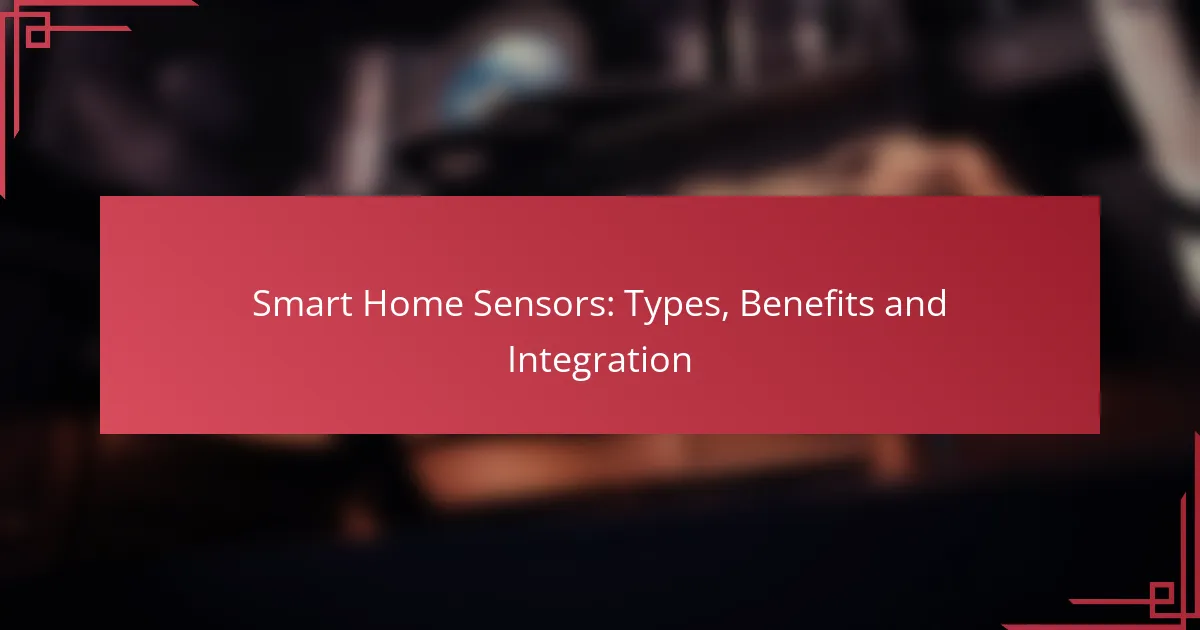Security cameras are essential tools for enhancing safety and monitoring both residential and commercial properties. With a variety of features such as high-definition video, night vision, and smart alerts, choosing the right camera can significantly impact its effectiveness. Understanding these features and their benefits, including crime deterrence and remote access, is crucial for making an informed decision.
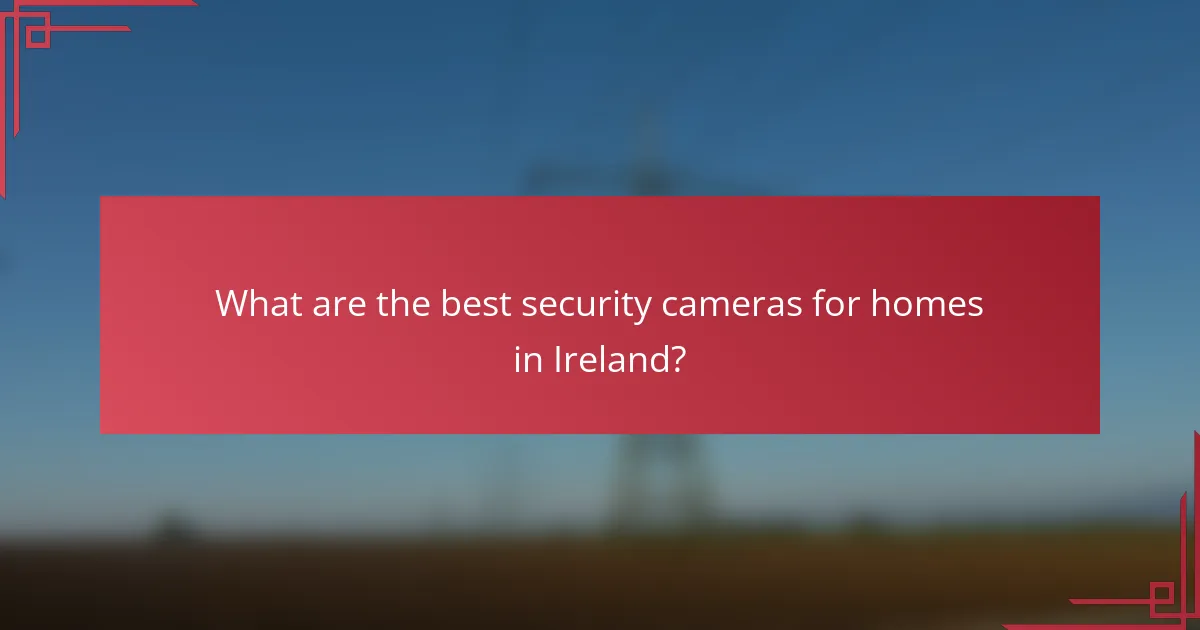
What are the best security cameras for homes in Ireland?
The best security cameras for homes in Ireland combine reliability, ease of use, and effective monitoring features. Popular options include models that offer high-definition video, smart alerts, and integration with home automation systems.
Ring Stick Up Cam
The Ring Stick Up Cam is a versatile security camera that can be used indoors or outdoors. It offers 1080p HD video, two-way audio, and motion-activated notifications, making it a solid choice for home security.
Consider the power options: it can be plugged in or run on battery, which adds flexibility in placement. The integration with the Ring ecosystem allows for seamless operation with other Ring devices.
Arlo Pro 4
The Arlo Pro 4 features 2K video resolution and color night vision, providing clear images day and night. It is wireless and weather-resistant, making it suitable for various outdoor conditions.
This camera includes a built-in spotlight and siren for added security. Subscription plans are available for cloud storage, but local storage options are also supported, which can save costs over time.
Google Nest Cam
The Google Nest Cam offers intelligent alerts and facial recognition capabilities, enhancing security by distinguishing between familiar faces and strangers. It provides 1080p video quality and integrates well with Google Home devices.
Users benefit from a user-friendly app that allows for easy monitoring and control. Subscription services provide additional features like 30 days of video history, which can be valuable for reviewing past events.
Reolink Argus 3
The Reolink Argus 3 is a battery-powered camera that offers 1080p video and a solar panel option for continuous power. It is designed for outdoor use and features a PIR motion sensor for accurate detection.
This camera supports local storage via microSD cards, which can help avoid ongoing subscription fees. Its affordability and ease of installation make it a popular choice for budget-conscious homeowners.
TP-Link Kasa Spot
The TP-Link Kasa Spot is an indoor camera that provides 1080p video and two-way audio. It is compact and easy to set up, making it ideal for monitoring pets or children at home.
It integrates with Kasa Smart home products and offers features like motion detection alerts. The camera’s affordability and straightforward app make it a great entry-level option for those new to home security cameras.
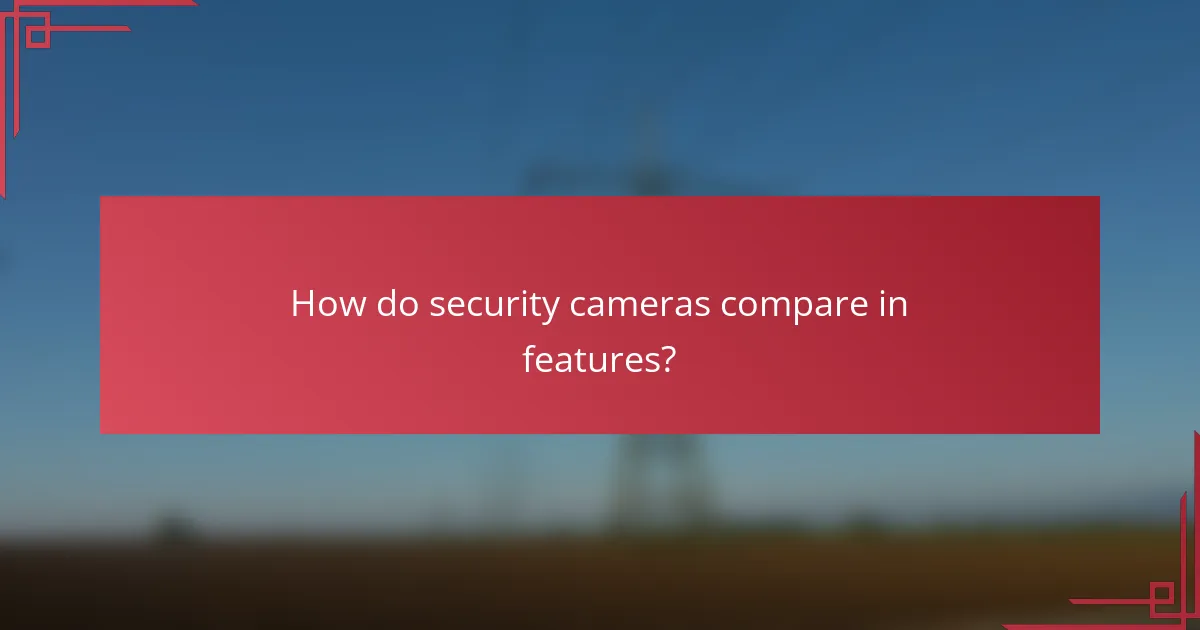
How do security cameras compare in features?
Security cameras vary significantly in features, impacting their effectiveness for different surveillance needs. Key aspects to consider include video resolution, night vision capabilities, and field of view, which all play a crucial role in determining the overall performance of a camera system.
Video resolution comparison
Video resolution is a critical factor in the clarity of the footage captured by security cameras. Common resolutions include 720p (HD), 1080p (Full HD), and 4K (Ultra HD), with higher resolutions providing more detail. For most residential applications, 1080p is often sufficient, while commercial settings may benefit from 4K for enhanced image quality.
When comparing cameras, consider the pixel density and the size of the area being monitored. Higher resolution cameras are ideal for larger spaces or when facial recognition is necessary. However, they may require more storage and bandwidth, so balance your needs with available resources.
Night vision capabilities
Night vision capabilities determine how well a security camera can capture images in low-light conditions. Most cameras use infrared (IR) technology, which allows them to see in complete darkness, while others may employ low-light sensors that enhance visibility without IR illumination.
When selecting a camera, look for features like IR range and the ability to switch between color and black-and-white modes. Cameras with a longer IR range can cover larger areas at night, providing better security. Be aware that some cameras may produce grainy images in low-light situations, so test performance in real-world conditions if possible.
Field of view differences
The field of view (FOV) of a security camera indicates how much area it can cover. FOV is typically measured in degrees, with wider angles allowing for more extensive monitoring. Standard FOVs range from 60 to 120 degrees, with panoramic cameras offering even broader coverage.
Choosing the right FOV depends on your specific surveillance needs. For narrow hallways, a camera with a narrower FOV may suffice, while larger outdoor areas may require a camera with a wider angle. Keep in mind that wider FOVs can sometimes lead to distortion at the edges, so assess the trade-offs based on your installation environment.
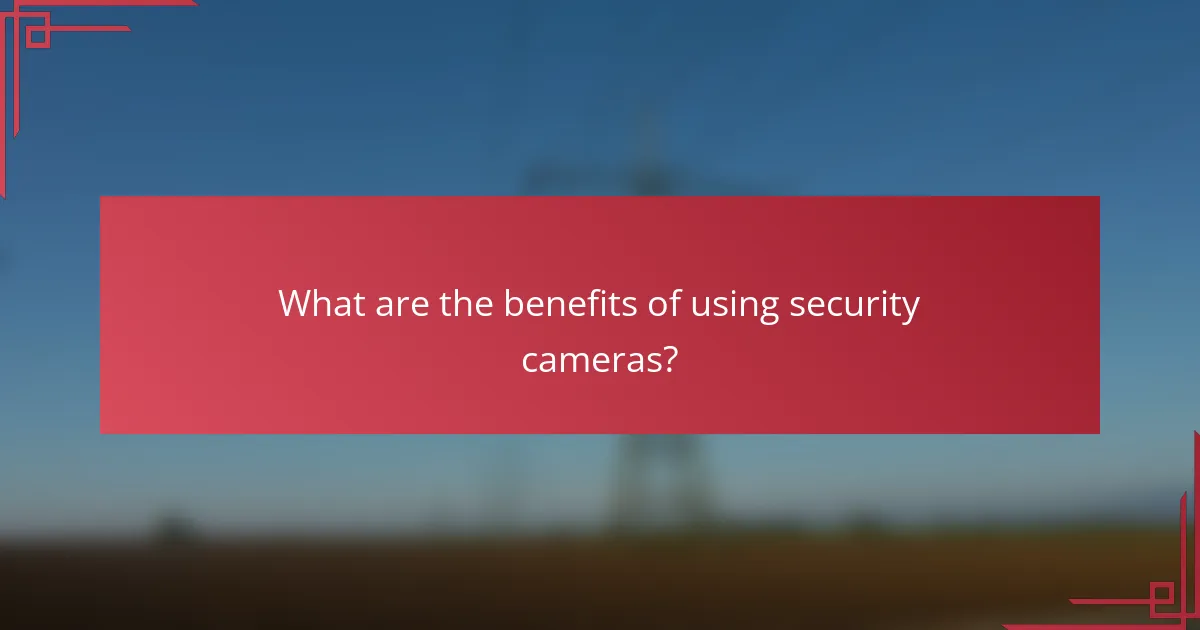
What are the benefits of using security cameras?
Security cameras offer numerous benefits, including crime deterrence, remote monitoring capabilities, and potential insurance discounts. These features enhance safety and provide peace of mind for both residential and commercial properties.
Deterrence of crime
One of the primary benefits of security cameras is their ability to deter criminal activity. Visible cameras can make potential intruders think twice before attempting a break-in, as the risk of being recorded and identified increases significantly.
To maximize this deterrent effect, place cameras in prominent locations, such as entrances and driveways. Additionally, using signage to indicate that the area is under surveillance can further discourage criminal behavior.
Remote monitoring
Security cameras enable remote monitoring, allowing property owners to keep an eye on their premises from anywhere via smartphones or computers. This feature is particularly valuable for those who travel frequently or manage multiple locations.
When selecting a camera system, look for models that offer live streaming and mobile app integration. Many systems also provide alerts for unusual activity, ensuring you stay informed in real-time.
Insurance benefits
Installing security cameras can lead to lower insurance premiums, as many insurers offer discounts for properties equipped with surveillance systems. This reduction can help offset the initial investment in camera technology.
To take advantage of these potential savings, inform your insurance provider about your security measures. Keep documentation of your camera system and any relevant certifications to ensure you receive the appropriate discounts.
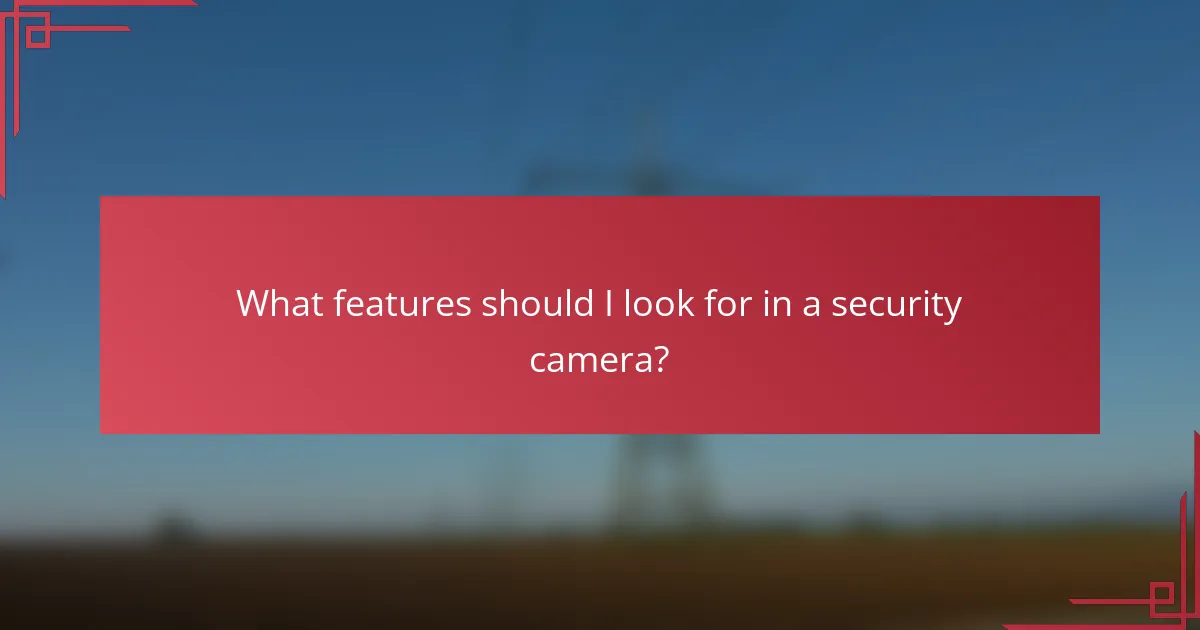
What features should I look for in a security camera?
When selecting a security camera, prioritize features that enhance surveillance effectiveness and usability. Key aspects include motion detection, two-way audio, and cloud storage options, which can significantly impact your security strategy.
Motion detection
Motion detection is a crucial feature that allows a security camera to identify movement within its field of view. This functionality can help reduce false alarms by triggering recordings or alerts only when activity is detected. Look for cameras with adjustable sensitivity settings to tailor the detection to your environment.
Some cameras offer advanced motion detection capabilities, such as differentiating between people, pets, and vehicles. This can help minimize unnecessary notifications and focus on relevant events. Consider models that allow you to set specific zones for motion detection to further refine alerts.
Two-way audio
Two-way audio enables communication through the security camera, allowing you to listen and speak to visitors or intruders. This feature is particularly useful for home security, as it can deter unwanted visitors and facilitate communication with delivery personnel. Ensure the camera has a clear microphone and speaker for effective interaction.
When evaluating two-way audio, consider the audio quality and latency. Look for cameras that provide real-time audio without significant delays, as this enhances the user experience. Some models also include noise cancellation features, which can improve clarity during conversations.
Cloud storage options
Cloud storage options allow you to save recorded footage off-site, providing access to video from anywhere with an internet connection. This is essential for ensuring that footage is safe from theft or damage to the camera itself. Many security cameras offer subscription plans with varying storage capacities and retention periods.
When choosing a cloud storage plan, consider the duration of video retention and the associated costs. Some services may offer free basic storage for a limited time, while others charge monthly fees based on the amount of footage stored. Evaluate your needs to select a plan that balances cost and functionality effectively.

How do I choose the right security camera for my needs?
Choosing the right security camera involves assessing your specific requirements, such as the area to be monitored, desired features, and budget. Consider factors like resolution, field of view, and connectivity options to ensure you select a camera that meets your security needs.
Consider your monitoring area
Start by evaluating the area you want to monitor. Indoor cameras typically have different specifications than outdoor models, which need to withstand weather conditions. For larger spaces, you may need multiple cameras or a model with a wider field of view.
Think about specific locations, such as entrances, driveways, or backyards. Each area may require different camera types, such as dome cameras for discreet indoor use or bullet cameras for visible outdoor surveillance.
Evaluate camera features
Key features to consider include resolution, night vision, motion detection, and two-way audio. Higher resolution cameras provide clearer images, which can be crucial for identifying faces or license plates. Night vision is essential for low-light conditions, while motion detection can alert you to unusual activity.
Some cameras offer smart features like facial recognition or integration with home automation systems. Determine which features are essential for your security strategy and which ones may be nice to have.
Set your budget
Your budget will significantly influence your choices. Security cameras can range from affordable models under $100 to high-end systems costing several hundred dollars. Consider not only the initial purchase price but also ongoing costs such as cloud storage subscriptions or installation fees.
Look for options that provide the best value for your needs. Sometimes, spending a little more upfront can save you money in the long run by avoiding frequent replacements or upgrades.

